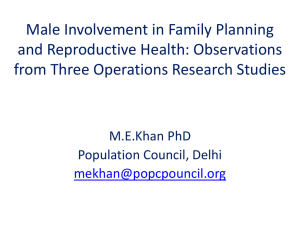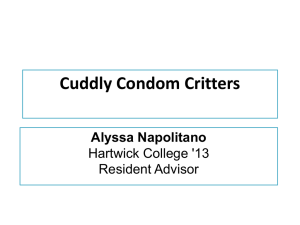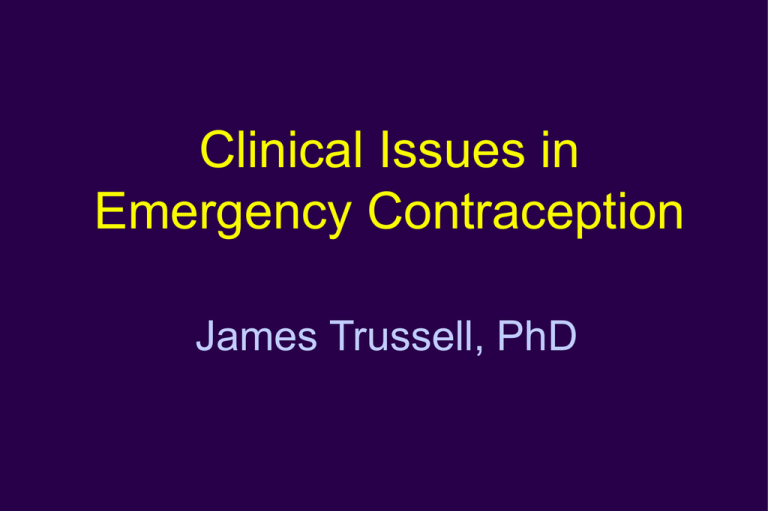
Clinical Issues in
Emergency Contraception
James Trussell, PhD
Objective: To Enhance Understanding
about These 7 Issues
1.
2.
3.
4.
5.
6.
7.
New Plan B regimen
Mechanism of action of ECPs
Does EC promote risk taking?
Are ECPs effective?
Beginning contraception after ECPs
When to expect menses after ECPs
Enhancing availability of EC
New Plan B Regimen
• Two studies have shown that both doses of
Plan B (both Plan B pills) can be taken at the
same time
– With no reduction in effectiveness
– With no increase in side effects
• One study has shown that two doses of Plan
B taken 24 hours apart are just as effective
as two doses taken 12 hours apart
• Two studies have shown that Plan B is
effective up to 120 hours after intercourse
Sources: Arowojolu et al. 2002; von Hertzen et al. 2002; Ngai et al. 2004
How MIGHT EC Work?
• Inhibit ovulation
• Trap sperm in thickened cervical mucus
• Inhibit tubal transport of egg or sperm
• Interfere with fertilization, early cell
division, or transport of embryo
• Prevent implantation by disrupting the
uterine lining
Mechanism of Action: LNg ECPs
• Clinical evidence about the effect of
progestin-only ECPs on ovulation, on uterine
lining characteristics, and on timing of the
next menstrual period
• Observed vs. expected pregnancies by
timing of administration relative to ovulation
• One published study of effect of small doses
of LNg on sperm motility
Source: Kesseru et al. 1974; Durand et al. 2001; Croxatto et al. 2001;
Hapangama et al. 2001; Marions et al. 2002; Croxatto et al. 2003;
Marions et al. 2004; Croxotto et al. 2004; Durand et al. 2005; Novikova
et al. 2007
Clinical Evidence: Progestin-only ECPs
• Progestin-only ECPs can inhibit ovulation but do not
always do so. Inhibiting ovulation may be the only
mechanism of action.
• Progestin-only ECPs may immobilize sperm by
altering uterine pH.
• Progestin-only ECPs can alter glycodelin in serum
and endometrium and can shorten the luteal phase.
Source: Kesseru et al. 1974; Durand et al. 2001; Croxatto et al. 2001;
Hapangama et al. 2001; Marions et al. 2002; Croxatto et al. 2003;
Marions et al. 2004; Croxotto et al. 2004; Durand et al. 2005; Novikova
et al. 2007
Animal Evidence: Levonorgestrel
• Studies in the rat and in the new-world
monkey Cebus apella
• Levonorgestrel administered in doses that
inhibit ovulation has no postfertilization effect
that impairs fertility
Source: Müller et al. 2003; Ortiz et al. 2004
Mechanism of Action of Hormonal
Contraceptives and IUDs
About the same amount of evidence for each of the
following statements:
– ECPs,
– OCs, implants, patches, rings, injectables,
– IUDs,
– The contraceptive effect of breastfeeding…
MAY work by inhibiting implantation of a fertilized egg
Source: ACOG 1998; Díaz et al. 1992
What Should Women Be Told?
• ECPs—like all regular hormonal contraceptives
such as the birth control pill, the implant Implanon,
the vaginal ring NuvaRing, the Evra patch, and the
injectable Depo-Provera, and even breastfeeding—
may prevent pregnancy by delaying or inhibiting
ovulation, inhibiting fertilization, or inhibiting
implantation of a fertilized egg.
• The best available evidence is consistent with the
hypothesis that Plan B’s ability to prevent
pregnancy can be fully accounted for by
mechanisms that do not involve interference with
post-fertilization events.
.
Source: Davidoff and Trussell 2006
Does Providing ECPs Increase Risk
Taking?
• Empirical evidence from 1 study in Scotland, 3
in San Francisco, 1 in Pittsburgh, 1 in Hong
Kong, 1 in China, 2 in Los Angeles, and 1 in
Nevada & North Carolina where women were
randomized to receive counseling and ECPs
on demand or to receive ECPs in advance for
later use should the need arise.
Source: Glasier and Baird 1998; Raine et al. 2000; Jackson et al. 2003;
Gold et al. 2004; Lo et al. 2004; Raine et al. 2005; Hu et al. 2005; Belzer
et al. 2005; Trussell et al. 2006; Raymond et al. 2006; Walsh et al. 2006
Results Scotland:
Women who received ECPs in advance
• Were more likely to use ECPs:
47% vs 27% of women who received only
counseling (p<.001)
• Were not more likely to use ECPs repeatedly
• Used other methods of contraception equally
well
• Had fewer unintended pregnancies:
3.3% vs 4.8 % for women who received only
counseling (p=0.14)
Source: Glasier and Baird 1998
Results San Francisco 1:
Women who received ECPs in advance
• Were more likely to use ECPs:
22% vs 7% of women who received only
counseling (p=.006)
• Were not more likely to have unprotected sex
• Were not less likely to use condoms
consistently
• Were less likely to use oral contraceptives
consistently: 32% vs 58% of women who
received only counseling (p=.03)
Source: Raine et al. 2000
Results San Francisco 2:
Women who received ECPs in advance
• Were more likely to use ECPs:
17% vs 4% of women who received only
counseling (p=.006)
• Were not more likely to change to a less effective
method of contraception
• Were not more likely to have unprotected sex
• Were not more likely to use contraception less
consistently
• Had fewer unintended pregnancies:
7% vs 10% for women who received only
counseling (p=0.16)
Source: Jackson et al. 2003
Results Pittsburgh:
Women who received ECPs in advance
• Were more likely to use ECPs:
15% vs 8% of women who received only
counseling (p=.05)
• Took ECPs sooner after sex (11 vs 22 hours)
• Were more likely to use condoms
• Were not less likely to use hormonal
contraception
Source: Gold et al. 2004
Results Hong Kong:
Women who received ECPs in advance
• Were more likely to use ECPs:
30% vs 13% of women who received only
counseling (p<.001)
• Were not less likely to use contraception
consistently
• Were not less likely to use condoms
• Took ECPs sooner after sex (14 vs 29 hours)
• Were not less likely to become pregnant
Source: Lo et al. 2004
Results San Francisco 3:
Women who received ECPs in advance
• Were more likely to use ECPs:
37% vs 21% of women who received only
counseling (p<.001))
• Were not more likely to have unprotected sex
• Were not less likely to use condoms or pills
consistently
• Were not more likely to acquire an STI
• Were not less likely to become pregnant
Source: Raine et al. 2005
Results San Francisco 3:
Women who received ECPs from a pharmacist
• Were no more likely to use ECPs:
24% vs 21% of women who received only
counseling (p=.25)
• Were not more likely to have unprotected sex
• Were not less likely to use condoms or pills
consistently
• Were not more likely to acquire an STI
• Were not less likely to become pregnant
Source: Raine et al. 2005
Results China:
Women who received ECPs in advance
• Were twice as likely to use ECPs
Were not less likely to use contraception
• Were not less likely to use condoms
• Were not less likely to become pregnant
Source: Hu et al. 2005
Results Los Angeles 1:
Women who received ECPs in advance
• Were more likely to use ECPs:
83% vs 11% of women at 6 months and 64%
vs 17% of women at 12 months who
received only counseling (p<.01)
• Were not more likely to have unprotected sex
• Were not less likely to use condoms
• Were not less likely to become pregnant
Source: Belzer et al. 2005; Trussell et al. 2006
Results Los Angeles 2:
Women who received ECPs in advance
• Were more likely to use ECPs:
19% vs 12% of women who received only
counseling (p<0.05)
• Were not more likely to have unprotected sex
• Were not less likely to use barrier methods or
pills
• Were not less likely to become pregnant
Source: Walsh and Frezieres 2006
Results Nevada & North Carolina:
Women who received ECPs in advance
• Were more likely to use ECPs:
71% vs 32% of women who received only
counseling (p<0.001)
• Were not more likely to have unprotected sex
• Were not less likely to use condoms or pills
• Were not more likely to acquire an STI
• Were not less likely to become pregnant
Source: Raymond et al. 2006
Are ECPs Effective?
• Eight of the ten studies conducted to test
whether easy assess to ECPs increased risk
taking also measured pregnancies
• In none of the eight did advance provision of
ECPs reduce pregnancy rates
• Only three studies powered to detect a
decrease in pregnancy rates
Raymond et al. 2007
Why No Reduction in Pregnancies?
• In San Francisco almost half of the women in
the advance provision group who had
unprotected intercourse did not use ECPs
• In China, 30 of the 38 pregnancies in the
advance provision group occurred to women
who did not use ECPs in that cycle
• In Nevada/NC, 57 of the 74 pregnancies in the
advance provision group occurred to women
who did not use ECPs in that cycle
• Lesson: ECPs are not used frequently enough!
Source: Raine et al. 2005; Hu et al. 2005; Raymond et al. 2006
Advance Provision of ECPs Did Not
Reduce Abortions Rates in Lothian
• Community intervention study in Scotland
• About 1 in 5 women aged 16-29 got ECPs in
advance to take home
• About half of these used ECPs at least once
• No effect on abortion rates was observed
• Women most at risk probably did not get ECPs
• 78% of women with advance supplies who got
pregnant did not use ECPs.
Source: Glasier et al. 2004
Excellent Evidence that Plan B Works
• Two trials in which women were randomly
assigned to Plan B or Yuzpe regimen.
• Pregnancy rate in Plan B arm was 51% of
the rate in the Yuzpe arm.
• Plan B is 49% effective if Yuzpe regimen is
completely ineffective.
• If, for example, Yuzpe regimen is 60%
effective, then Plan B is 79% effective.
Source: Raymond et al. 2004
Excellent Evidence that Plan B Works
Effectiveness of LNg
100%
80%
60%
40%
20%
0%
0%
25%
50%
75%
Effectiveness of Yuzpe
LNg effectiveness
Lower 95% CI
Source: Raymond et al. 2004
Lessons Learned
• ECPs are not used nearly frequently enough!
• Women underestimate their risk of
pregnancy
• More education is needed
• OTC switch is necessary―but not
sufficient―for solving this problem
• Major public health impact is unlikely
Beginning Contraception after EC
• Oral contraceptives, patches, and vaginal
rings, and injectables
– Regular start: use backup until next period, then
begin new method according to regular patient
instructions
– Jump/quick start: take 2 ECP doses. Start new
method the next/same day (use backup for first
seven days)
Initiating Ongoing Method:
•
•
•
•
Condoms
Spermicides
Diaphragm
Implant
• Mirena
immediately
immediately
immediately
within 7 days after
next menses *
after next menses *
* backup until menses
Bleeding Patterns After Plan B
• Two studies specifically designed to assess
the effects of ECPs containing 1.5 mg
levonorgestrel taken in a single dose on
bleeding patterns
Source: Raymond et al. 2006; Gainer et al. 2006
Bleeding Patterns After Plan B―1
• The first study found that when taken in the
first three weeks of the menstrual cycle,
ECPs significantly shortened that cycle
compared both to the usual cycle length and
to the cycle duration in a comparison group
of similar women who had not taken ECPs.
The magnitude of this effect was greater the
earlier the pills were taken.
Source: Raymond et al. 2006
Source: Raymond et al. 2006
Bleeding Patterns After Plan B―1
• This regimen taken later in the cycle had no
effect on cycle length, but it did cause
prolongation of the next menstrual period
• The ECPs had no effect on the duration of
the post-treatment menstrual cycle, but the
second period was prolonged
• Intermenstrual bleeding was uncommon after
ECP use, although more common than
among women who had not taken ECPs
Source: Raymond et al. 2006
Bleeding Patterns After Plan B―2
• The second study compared the baseline cycle
with the treatment and post-treatment cycles.
Cycle length was significantly shortened by one
day when ECPs were taken in the preovulatory
phase of the cycle and was significantly
lengthened by two days when ECPs were
taken in the postovulatory phase. No difference
in cycle length was observed for women who
took ECPs during the periovulatory phase of
the cycle (from two days before to two days
after the expected day of ovulation).
Source: Gainer et al. 2006
Bleeding Patterns After Plan B―2
• Menstrual period duration increased
significantly when ECPs were taken in the
periovulatory or postovulatory phase in both the
treatment and post-treatment cycles.
• The duration of the post-treatment menstrual
cycle remained significantly longer when ECPs
were taken in the postovulatory phase.
• During the treatment cycle, 15% of women
experienced intermenstrual bleeding; this was
significantly more common when ECPs were
taken in the preovulatory phase
Source: Gainer et al. 2006
EC Hotline and Website
• Emergency Contraception Hotline
– 1-888-NOT-2-LATE
– 630k calls since 1996
• Emergency Contraception Website
– http://not-2-late.com
– 3.2m visits since 1994
Providers on the Hotline and Website
State Websites: Prescriptions Called In
•
•
•
•
•
•
•
•
•
•
•
Georgia: www.ecconnection.org
Illinois: www.plannedparenthoodchicago.com
Indiana: www.ppin.org/ecaccess/ecinfo.html
Maine: www.ppnne.org
Massachusetts: www.pplm.org
North Carolina: http://www.pphsinc.org/ec/
Oregon: www.ppcw.org
South Carolina: http://www.pphsinc.org/ec/
Vermont: www.ppnne.org
Washington: www.ppcw.org
West Virginia: http://www.pphsinc.org/ec/
Statewide Hotlines: Prescriptions Called In
•
•
•
•
•
•
•
•
•
•
•
•
•
•
Connecticut: 800-230-PLAN
Georgia: 877-ECPills
Illinois : 866-222-EC4U or 217-544-2744
Maryland: 877-99-GO-4-EC
Massachusetts: 800-682-9218, 642-5665, 539-2378
Michigan: 734-973-0710
Minnesota: 612-625-4607
Montana: 800-584-9911
New Mexico: 505-272-9304
New York: 585-271-9055
North Carolina: 866-942-7762
South Carolina: 800-230-PLAN
West Virginia: 800-230-PLAN
Wisconsin: 877-975-9858
States with Call-in Prescriptions
39% of women aged 15-44
Emergency Contraception BTC
ECPs are available directly from pharmacists
without having first to get a prescription in:
•
•
•
•
•
•
•
•
Alaska
California
Hawaii
Maine
Massachusetts
Montana
New Hampshire
New Mexico
•
•
•
•
•
•
•
•
Vermont
Washington
Canada
France
United Kingdom
Australia
South Africa
33 other countries+5 OTC
Pharmacists Providing ECPs

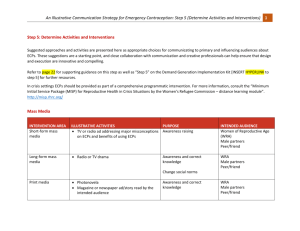
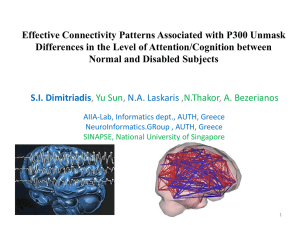
![view Unit 14: Emergency Contraceptive Pills [PDF 319KB]](http://s3.studylib.net/store/data/008439478_1-6df94ca90794562e31dfc68f6a601d55-300x300.png)





